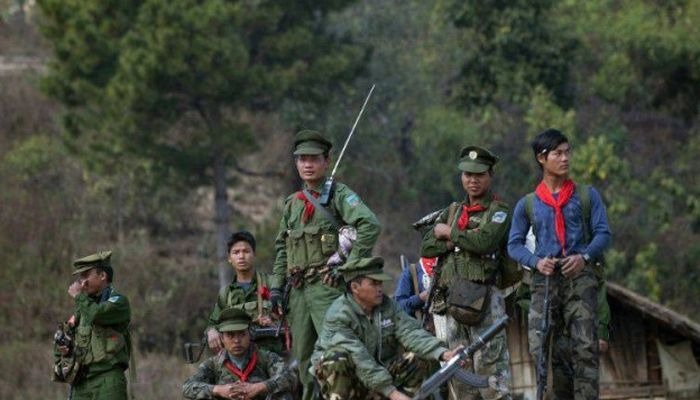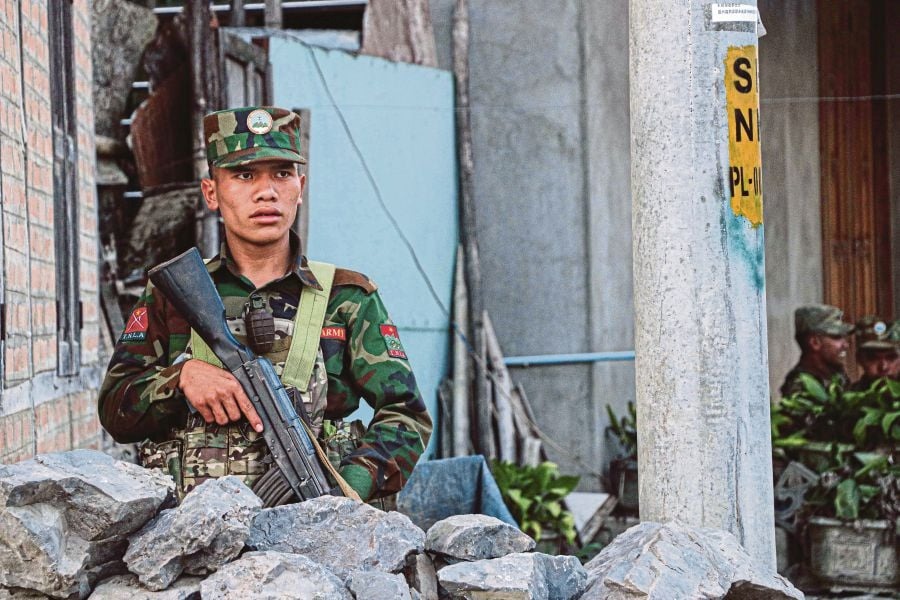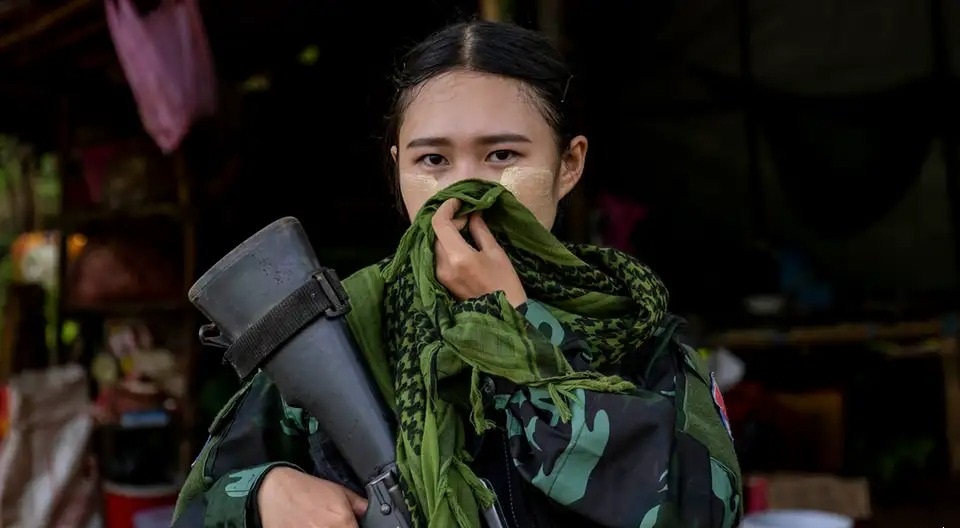Rebels deploy drones against Myanmar junta

Rebel drone squadron, comprising engineering students and hobbyists, gains battlefield skills from YouTube tutorials, proving pivotal against Myanmar’s oppressive military regime.
Hovering silently above the Chin hills in western Myanmar, the drones caught the junta off guard. The operators, concealed in the dense forest a few hundred meters away, observed their screens as the drone fleet positioned precisely over the target—a crucial military base in Lailenpi. When the operators confirmed the alignment, they pressed the button on their controllers, initiating the release of bombs.
“We achieved accurate hits,” explained Noah, a 20-year-old member of the Chin National Army (CNA), a rebel group engaged in a nearly three-year-long conflict against Myanmar’s military. “It caught them off guard. We inflicted casualties, including the second-in-command of the base.”
Following three days of intense fighting, the rebels raised their tricolor flag over the base, celebrating their victory with triumphant slogans.
In the ongoing conflict between the military junta, which seized control through a coup in February 2021, and the rebel groups striving to reinstate democracy, a significant transformation is evident.
The junta has now relinquished control over more than 50% of the country. In Chin state, bordering India, the rebel forces of the Chin National Army (CNA) claim to have recaptured 70% of the province, including five crucial military bases.
They attribute their recent successes to a new drone fleet and a force of rebel soldiers, many of whom were once civilians, dedicating over a year to training for drone operations. “Drones have been pivotal to our success,” affirmed Ram Kulh Cung, the CNA’s assistant general secretary, emphasizing that attacks, like the one in Lailenpi, result from months of meticulous planning and training.
During a recent tour of Camp Victoria, the central headquarters of the Chin National Army (CNA) in Chin state, they exhibited to The Observer a substantial fleet of thousands of commercial and agricultural drones, also known as unmanned aerial vehicles. These drones were imported primarily from China, but also from Western countries such as the United States. The purpose is to conduct targeted attacks on territories controlled by the military junta.
Since the Tatmadaw, the military, seized power, they have orchestrated a harsh nationwide crackdown. The soldiers have faced allegations of arbitrary arrests, torture, mass killings, rapes, and various abuses, constituting crimes against humanity, as per Human Rights Watch. The conflict following the coup has reportedly resulted in the deaths of over 4,000 civilians.
Until recently, the military enjoyed a significant advantage with a sophisticated air force, frequently deploying it for hundreds of lethal airstrikes. These strikes, often directed at areas of resistance, have resulted in the deaths of thousands.
However, maintaining and operating the fleet of fighter jets has proven costly for the junta. Moreover, these jets are increasingly inadequate in comparison to the cheap and skillfully employed drones utilized by rebel armies against military-controlled areas.
Acknowledging the challenges, junta spokesperson Zaw Min Tun admitted to facing heavy assaults, with insurgents effectively using drones to drop numerous bombs on military posts.

Indian army officials reported that most border posts on the Myanmar side had either been overrun by rebels or were under threat. Over the past two months, more than 400 Myanmar army soldiers have fled across the border to the Indian state of Mizoram following rebel attacks.
The success of drone technology in rebel warfare has been so profound that the junta has also resorted to using commercial drones for attacks. However, they lack the necessary training to utilize them as efficiently as the rebel fighters.
The use of drones has created a tectonic shift in Myanmar’s battlefield,” noted Angshuman Choudhury, an associate fellow at the Delhi-based think tank Centre for Policy Research. “While it hasn’t completely closed the tactical asymmetry between the military and resistance forces, it has significantly diminished it.
He remarked that the drones have instilled a “sense of fear among the junta rank-and-file that they are being discreetly watched and could face aerial attacks anytime, anywhere—an idea that was unthinkable before the coup.
The Chin National Army (CNA) now boasts a dedicated drones department, established over a year ago, where foot soldiers have learned to operate the technology primarily through months of practical experience and tutorials on YouTube.
The drone department comprises skilled young fighters—some with engineering backgrounds and others who have acquired drone knowledge as a hobby,” stated Cung. “The department heavily relies on the internet to enhance skills and train more individuals.
While the technology is “turning the tables, Cung emphasized, “Procuring weapons and drones is not easy for us. There is nothing easy in war.
Commanders noted that most military equipment enters through the borders with China and Thailand, as India maintains strict control over the influx of weapons.
The leadership of the Chin National Army (CNA) also attributes the recent victories of the resistance forces to an enhanced alliance and improved coordination among various armed ethnic minority groups fighting the junta across Myanmar. Historically, these groups did not always collaborate seamlessly due to differing priorities and internal conflicts.
In late October, three insurgent groups, collectively known as the Three Brotherhood Alliance, initiated Operation 1027″ to confront junta troops in Shan state, near Myanmar’s border with China. Building on the nationwide momentum of the assault, additional rebel groups, including the Arakan Army and CNA, extended support from their respective regions. As a result, the offensive led to the capture of several towns and over 100 military outposts from the junta.
Last week, indicating a perceived weakening of the junta, the military and a coalition of rebel groups announced a China-mediated ceasefire along Myanmar’s border with China. However, the Chin National Army (CNA) did not participate, and commanders affirmed to The Observer that they would not adhere to the ceasefire in Chin state.

At the headquarters of Camp Victoria, where morale is high following recent victories, hundreds of newly recruited cadets participate in a daily parade. However, the adjacent cemetery serves as a poignant reminder that this battle remains challenging. Over two dozen young fighters, killed in recent operations, have been laid to rest, their tombstones adorned with lines of valor commemorating their actions in battle.
Despite the difficulties, drones have introduced a new dimension to warfare for Myanmar’s rebel armies, instilling renewed confidence in their ability to challenge the junta. Sabu, a 49-year-old commander in the CNA’s drones department, expressed optimism, stating, “We were ineffective in using them initially and missed most targets in the first year.” However, the dedicated training is now yielding results, with several recent successful ground offensives against the junta preceded by pre-dawn drone strikes. Sabu summarized, “Drones are our air force.


